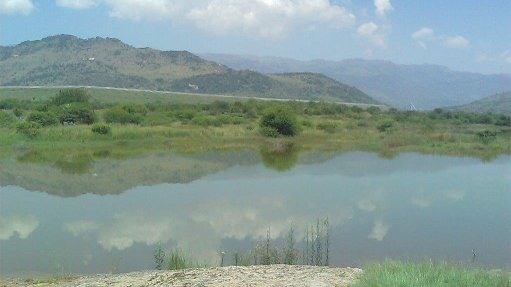
EVERY DROP COUNTS Mines need to reduce their water consumption and also take into consideration the increasing need for water as the population grows
Treating mine water has become more common as the mines try to minimise their impacts.
This has allowed for different types of water treatment options to enter the market, as well as a growing understanding of the environmental and economic impact, and where the water can be used to support other growth industries in the area, says consulting engineers and scientists SRK Consulting partner and principal hydrologist Peter Shepherd.
“A few decades ago, it was unthinkable that mine water would be treated and sold to municipalities for residential and industrial use. “As water supply to towns and cities is under pressure, [there is] increased interest in mine water.”
Consequently, the demand for the treatment of mine water has increased exponentially because of the requirement for a much higher level of responsibility that mining has bought upon itself in the past few years and partly because of water shortages in the country that will worsen in the coming years, Shepherd explains.
Changing Strategies
Shepherd says the growing pressure on South Africa’s water supply as the population grows, combined with the impact of climate change, has raised the bar for water management at mines.
He reiterates that access to water has become a key sustainability risk for mining operations, which must be mitigated by the correct policies and strategies.
“As water management has also become highly regulated, mines have become more systematic in the way they control their use of surface water and groundwater.”
Shepherd notes that the main concern is controlling the water balance – the quantities entering the system must be closely aligned with the volumes that leave the system to avoid shortages and prevent dangerous spillages.
More stringent government regulations also cover environmental risk, which relates to water-borne pollution that a mine may cause by discharging water.
“Good water management can reduce this risk, leading to less pollution and a reduced liability when the mine reaches its closure phase,” he asserts.
In addition to strategies that reduce water contained in tailings dams, mines are also implementing another valuable strategy: compartmentalising return water dams. This allows for water of different qualities to be stored within the same facilities, which helps to create a water hierarchy.
This hierarchy ensures that water is only treated or purified to the minimum level required by its purpose, helping, for instance, to preserve and economise the use of potable water.
“More water reuse is required and industry should ensure that it is optimally reused in the processes according to its quality. Using a water-quality hierarchy enables mines to ensure that water is not unnecessarily treated if its application does not demand it.”
Challenges
There are environmental risks related to spillages. With the increased variability in rainfall patterns, there is a higher risk that existing water storage facilities may not cope with severe downpours, Shepherd says.
“The danger of spillages and overtopping needs to be reassessed and mitigated to ensure that a mine does not breach environmental regulations by allowing dirty water to leave the mine boundary.”
Other major water challenges that mining faces include reducing overall consumption and avoiding any discharge into the surrounding water resources.
Using less water is vital considering the growing competition for water, he says.
Shepherd suggests that rainwater be carefully managed so that it can be effectively stored and integrated into a mine’s operations, as it can reduce the cost of buying water from outside suppliers.
Water Use
SRK Consulting is pursuing innovative, new ways to reuse water and minimise the amount of treatment using the correct water in the correct places.
The company, for example, was instrumental in securing treated sewage water for a mine and developing plans to reuse it in various mine processes, which subsequently reduced the mine’s demand for potable water by 45%.
The mine’s reticulation system needed to be modified to accommodate the change in water use from potable water to industrial water. A sand filter was installed to remove sediment immediately before certain processes, while the water for other parts of the mine needed to be treated to remove some of the salts.
“Treated sewage water is frequently used as part of a mine’s process water; this reuse assists municipalities too, as they can use the additional income they receive for the water towards maintaining their own sewage systems,” says Shepherd.
He adds that there are numerous methods to treat mine water and the preferred treatment method depends on numerous parameters, such as the final quality of the water required, the main poor-quality constituents that need to be treated, the volume of the water being treated and the purpose for which it will be used.
While mine plans and the rate of mining were based on economic parameters in the past, the volume of water available to mines has become a limiting factor in determining how much a mine can produce.
“The greater the reuse of water, the greater the throughput of mine ore can be,” Shepherd concludes.